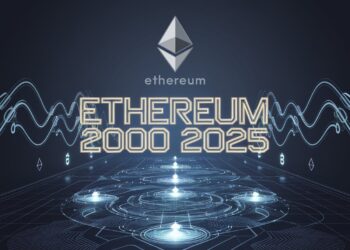Imagine a bustling digital highway suddenly falling silent, with only a few cars passing through. This is the state of Ethereum’s blockchain in April 2025, where transaction fees have plummeted to their lowest in five years. For a network that once buzzed with relentless activity, this quiet period raises questions about Ethereum’s current health and future trajectory. Is this a sign of trouble, or an opportunity for new growth?
Ethereum’s Fee Collapse: A Deep Dive into the Quiet Blockchain
Ethereum, the backbone of decentralized finance and smart contracts, is experiencing an unprecedented drop in transaction fees. At an average of $0.17 per transaction, costs haven’t been this low since May 2020. This phenomenon, while a relief for users, reflects a significant slowdown in network activity, prompting a closer look at what’s driving this trend.
Why Are Ethereum Fees So Low?
The sharp decline in Ethereum’s transaction fees stems from a simple economic principle: supply and demand. When the network is flooded with transactions, users bid higher fees to prioritize their actions, driving up costs. Today, with fewer transactions and interactions with smart contracts, the competition for block space has dwindled, resulting in rock-bottom fees.
Lower activity on Ethereum means less congestion, which directly translates to cheaper transactions for users.
– Blockchain Analyst
Data from blockchain analytics platforms confirms this trend. The number of daily transactions on Ethereum has dropped significantly in Q1 2025, correlating with reduced engagement in decentralized applications (dApps) and non-fungible token (NFT) markets. This slowdown mirrors broader market uncertainty, with external factors playing a pivotal role.
A Broader Market in Turmoil
The cryptocurrency market is no stranger to volatility, but recent global economic developments have intensified the pressure. Policy shifts, including proposed tariffs and regulatory uncertainties, have rattled investor confidence. Ethereum’s native token, ETH, has not been spared, shedding over 12.5% of its value in the past two weeks, stabilizing around $1,600.
Ethereum’s price struggles reflect a broader market downturn, with many cryptocurrencies facing similar declines amid economic uncertainty.
This market correction has dampened enthusiasm for high-risk assets like cryptocurrencies. For Ethereum, the impact is twofold: reduced trading activity and fewer interactions with its ecosystem of dApps and decentralized finance (DeFi) protocols. The result is a quieter blockchain, but one that still holds immense potential.
The Pectra Upgrade: A Beacon of Hope
Amid the current lull, Ethereum’s upcoming Pectra upgrade, scheduled for May 7, 2025, offers a glimmer of optimism. This major update promises to enhance the network’s scalability, efficiency, and user experience, potentially reigniting activity. But what exactly does Pectra bring to the table?
- Improved Scalability: Pectra aims to optimize transaction processing, reducing bottlenecks.
- Enhanced Smart Contracts: New features will make dApps more efficient and developer-friendly.
- Lower Costs: Further refinements to gas fees could make Ethereum more accessible.
The Pectra upgrade has already been successfully deployed on the Hoodi testnet, signaling a smooth rollout. For developers and users, these improvements could lower the barriers to entry, encouraging renewed engagement with Ethereum’s ecosystem.
Ethereum’s Dominance in Revenue
Despite the drop in activity, Ethereum remains a titan in the blockchain space. In Q1 2025, the network generated $1 billion in revenue, underscoring its unmatched dominance. This revenue, derived from transaction fees and other network activities, highlights Ethereum’s resilience even in challenging times.
| Blockchain | Q1 2025 Revenue | Market Share |
|---|---|---|
| Ethereum | $1B | 55% |
| Solana | $350M | 20% |
| Binance Smart Chain | $200M | 15% |
This financial strength positions Ethereum to weather the current storm. However, sustaining this dominance will require addressing the challenges posed by reduced activity and competition from rival blockchains like Solana.
The Role of Layer 2 Solutions
As Ethereum’s mainnet experiences a slowdown, Layer 2 solutions like Arbitrum and Optimism are gaining traction. These scaling solutions process transactions off-chain while leveraging Ethereum’s security, offering faster and cheaper alternatives for users.
Layer 2 Solutions
Secondary frameworks built on top of Ethereum that handle transactions off the main blockchain, reducing costs and improving speed while maintaining security.
The rise of Layer 2 networks has diverted some activity from Ethereum’s mainnet, contributing to the fee reduction. However, this shift also demonstrates Ethereum’s adaptability, as these solutions expand the network’s capacity to handle diverse use cases.
What Does This Mean for Investors?
For investors, Ethereum’s current state presents both risks and opportunities. The low fees make it an attractive time to engage with dApps or transfer ETH, but the broader market downturn and reduced activity signal caution. Here’s a breakdown of the key considerations:
Key Takeaways for Investors
- Low fees reduce the cost of interacting with Ethereum’s ecosystem.
- The Pectra upgrade could drive renewed interest and activity.
- Market uncertainty warrants a cautious approach to ETH investments.
Long-term investors may view this as a buying opportunity, especially with the Pectra upgrade on the horizon. However, short-term traders should monitor market trends closely, as external economic factors continue to influence ETH’s price.
The Bigger Picture: Ethereum’s Future
Ethereum’s current challenges are a snapshot of a dynamic and evolving ecosystem. While low fees and reduced activity may seem concerning, they also reflect a natural ebb and flow in the crypto market. The network’s ability to adapt through upgrades like Pectra and the growing adoption of Layer 2 solutions positions it for a potential resurgence.
Ethereum’s strength lies in its ability to innovate and evolve, even in the face of market challenges.
– Crypto Market Observer
As the crypto market navigates economic uncertainties, Ethereum’s role as a leader in blockchain technology remains unchallenged. The coming months will be critical, with the Pectra upgrade serving as a potential catalyst for renewed growth. For now, the quiet blockchain offers a moment of reflection—and opportunity—for those willing to look beyond the noise.
Ethereum’s journey is far from over. As the network prepares for its next chapter, the question remains: will low fees and the Pectra upgrade spark a new era of growth, or is this the calm before a larger storm?












